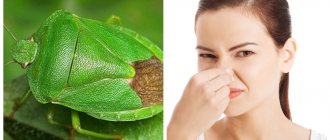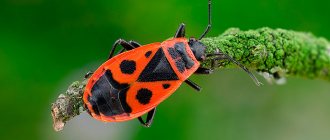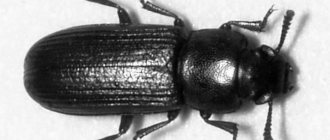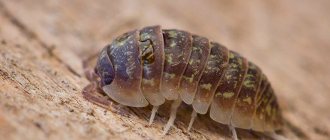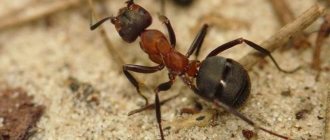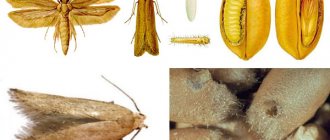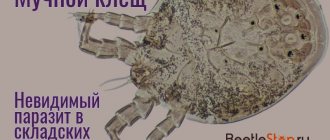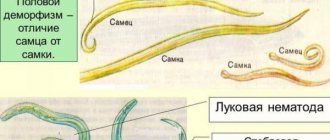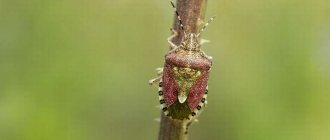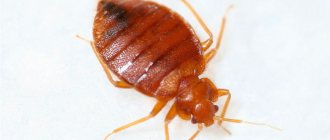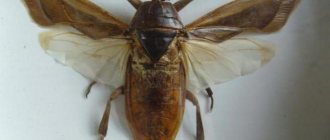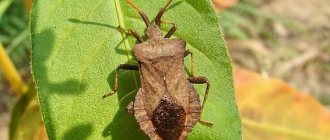The stink bug is a very common insect. They have a chitinous shell, shaped like a shield, for which they are called shield bugs. The shell protects the bug from the external environment.
The bug lives near bodies of water and feeds on the juice of plants, berries, cereals and the remains of other insects.
The stink bug is known for its unpleasant odor due to a substance secreted by the scent glands in case of danger.
But this property of the insect is also used for the benefit of people. A method of treating alcoholism using vodka tincture on wood bugs has long been known. This article will tell you what types of stink bugs there are, how to recognize this insect, what harm it can cause to the crop and how to fight the pest.
REPRODUCTION
Shield bugs usually breed in the summer. When pairs form in these insects, smell plays an important role. Individuals of different sexes use it to find and recognize each other. Many species do this using sounds reminiscent of the chirping of a cricket, which are formed as a result of friction of the hind legs. Before fertilizing the female, the male shield bug performs a kind of “overture,” during which he circles around the female and gently touches her body with his head.
The male “sings” and moves his antennae. During mating, the genital organs of insects are firmly connected, and their heads are directed in opposite directions. They often remain in this position for several hours. The females then lay eggs. Herbivorous species look for special plants for these purposes, while predatory species are less picky in this regard - their testicles can be found on the inside of leaves or around plant stems. The female shield guards the testicles. If anyone disturbs her, she covers them with her body like a shield. The hatched larvae hide under the female, who continues to take care of them. Shield insect larvae are small, wingless miniatures of their parents. Their color resembles that of an adult. The larvae molt four times. After the fifth molt, they already become adult insects.
Where does it live in winter and how does it reproduce?
The wood bug is found only in nature, where there are plants on which they feed.
They appear around April, with the first warm days, and closer to November they are practically nowhere to be seen, because... they hide for hibernation in moss, in tree cracks, etc.
These insects breed mainly in the spring, when it is already sunny and warm.
One female can lay up to 100 or more eggs, most often on the back of the leaves of various plants.
Under favorable conditions, such as warm weather, the larvae are born in 7-10 days.
If the cold does not pass for a long time, then the larvae will appear noticeably later, after about 30-40 days.
The average lifespan of wood bugs is 365 days.
WHAT DOES IT EAT?
The diet of these bugs is quite rich and varied. Shield insects live on herbaceous plants, shrubs, and trees, so many species of these insects suck juices from plants and seeds, into which they first inject digestive juice. Special bacteria found in their digestive tract help digest food. Females wipe the testicles with the contents of the digestive tract, which contains cultures of these bacteria, in order to transfer them to the larvae, which hatch. Most stink bugs will catch any prey they can lay their hands on. They even hunt those abandoned by other predators.
Pest Control Products
When there is a noticeable increase in the number of harmful stink bugs in the garden or vegetable garden, insecticidal poisons such as karbofos or chlorophos are used. But at the same time, chemicals also reach the crop. Therefore, the safest way to get rid of pests in your garden plot is to collect insects by hand, especially since they are not very fast.
To repel bedbugs, the so-called black cohosh, or black cohosh, is often planted in the garden and shrubs. The plant has an unpleasant, pungent aroma that repels stink bugs.
An infusion of onion peels or mustard powder diluted in water can also repel pests from garden vegetation. To do this, spray the garden and shrubs with a solution prepared from 200 grams of onion peels or 100 grams of mustard per 10 liters of water. The smell of onions and mustard drowns out the aroma of berries and vegetables: this protects the crop from stink bugs and other insect pests.
American scientists are looking for a new way to scare away stink bugs from green spaces. They are developing a drug containing artificially created analogues of insect pheromones (attractant drugs). This should, in their opinion, affect the sense of smell of stink bugs and distract pests from the harvest of fields, orchards and vegetable gardens.
If, by chance, a stink bug gets into your apartment, there is no need to worry too much: it is not dangerous to humans. Just throw it out the window. Cases of large concentrations of stink bugs in residential areas have not yet been observed, since the main food for these insects is tree foliage, fruits, berries, and cereals. If you are still worried about the appearance of these uninvited guests in your apartment, simply protect your home with a mosquito net.
PROTECTION AGAINST NATURAL ENEMIES
Shieldbirds live in constant danger - they can always become victims of birds. Therefore, most species that are at risk have reliable protective devices. If these are insects that feed on plant juices, then their shields will usually be green, and those species that live on the bark of trees, as a rule, have a gray or brown color. Many species that eat plants taste very bad or contain poisonous substances, in which case other animals do not eat them.
Expert advice
Evgeniya Vitalievna Marinina, entomologist, 16 years of work experience:
Marinina Evgenia Vitalievna Entomologist, researcher. Work experience 16 years.
• to irrigate the area, you need to prepare a household sprayer: you can take it from friends or rent it; if you use a sprayer or just water the plants, the treatment will be uneven; • the proportions should not be violated when preparing the products, this will lead to a decrease in effectiveness, the solution will be too weak; • irregular treatment will lead to the fact that the bugs will not feel the effects of the toxic substance, you need to carry out the irrigation procedure on time, then there will be a result.
Household sprayer for treating plants
LOCATION
Shield insects inhabit very different regions - from mountains to tropical mangrove swamps. Many species of these insects live in deserts. Shield insects living in the tropical zone are the most brightly colored among all other species. There are approximately 60 species of bedbugs living in Europe, most of which are unremarkable in appearance. In addition to stink bugs, there are families of bugs such as bed bugs, which suck the blood of vertebrates and even humans. In Europe, a “domestic predator” is widespread, which exterminates flies in houses.
Bedbug in a city apartment
If a shield bug gets inside a home, there are several reasons for this:
- The apartment is warm, but the cold came prematurely. Due to sudden frosts, the beetle crawled through the window, trying to find more comfortable living conditions.
- Flood, forest fire.
- The insect ended up in the apartment along with berries; more often it is brought in raspberries.
Considering that an insect of this family cannot harm a person or even bite, it should therefore be released.
SHIELD BIRD OBSERVATIONS
Shield insects can be observed throughout the year, at any time. In early spring, red stink bug is often found on plants. He is the owner of a red-brown color. This is one of the first insects that heralds spring. In summer, while picking wild berries, you can see the berry bug. Autumn is the best time to observe stink bugs, as most species of these insects are often the last insects to be found in the wild before winter sets in.
Dangerous bugs
Bugs are plant pests found everywhere. There is a strong threat from them in large numbers.
- Green forest shield. Insects live in the forest. Bugs live on raspberries almost the entire season. They feed on leaf juices, but can often be seen on berries. Raspberries that have recently been visited by a forest dweller leave a tart taste, bitterness, and an unpleasant odor. In the garden it settles on raspberry and currant bushes.
- Cruciferous bug. Bright red color with a black ornament on the carapace, a pattern in the form of a cross. The harmful garden bug settles on radishes, cabbage, and radishes. It can parasitize from early spring to late autumn. Threatens the development of crops and reduces yields.
- Pear. Bugs on trees are brown in color with an openwork pattern on the body. A very interesting appearance that arouses interest in nature among nature lovers. They settle on quince, pear, apricot, apple, and plum trees. Large colonies of pests threaten young trees with death. With a small amount, individual leaves are affected.
- Berry shield. Body color is green with brown. Bugs are found on currants, raspberries, and gooseberries. When a bush is heavily infested, an unpleasant odor is felt, which the insects emit during the mating period, when there is danger.
- Cucumber. The smallest harmful bugs in the garden. It's not just cucumbers that are affected. They settle on tomatoes, sweet peppers, and eggplants. The fruits are not harmed, but if the infection is severe, the leaves curl, darken, and fall off. It hides from the sun's rays and is located on the back side of the leaves. Blends in color. Almost invisible. Jumps quickly.
Bugs are plant pests
INTERESTING FACTS. DID YOU KNOW THAT...
- There is one species of shieldfish that has adapted to life in the Arctic ice.
- The female takes care of the offspring for many weeks; when the larvae become adults, they die.
- Many species of stink bugs, in case of danger, immediately release a specific liquid with a pungent “bedbug” odor, which is why they are called “stinking bugs.”
- Shield insects carefully take care of egg laying - they pay much more attention to them than other insects, except, of course, bees, wasps and ants.
Prevention
Simply following the rules of agricultural technology can significantly reduce the number of bugs on raspberries. For example, branches cut off during sanitary pruning, fallen leaves and all debris under bushes should be removed and burned. Even such a simple event will allow you to get rid of most of the pests that have settled down for the winter.
Some bugs spend the winter in the upper layers of the soil. If you dig up the area for the winter (without breaking the earthen ball), then the sleeping bugs will freeze and, quite possibly, such preventive measures will be enough to completely forget about the stink bug.
Unfortunately, such measures do not protect against “guests” from the neighboring garden or the nearest forest. Bedbugs fly well and are able to quickly “master” new territory. In small areas of raspberries, you can get by with manual collection of insects or get the hang of shaking bugs from raspberry branches into a container with a lid.
CHARACTERISTICS
Shield insects have a movable proboscis, with which they pierce the integument of the body of an animal or plant and suck out blood or cell sap. In some species, the proboscis is located at the bottom of the body.
Two pairs of wings, the first of which are typical semi-rigid elytra.
— Habitat of shieldbills
WHERE DOES IT LIVE?
All over the world, in almost all climate zones. Most species live in the tropics.
PROTECTION AND PRESERVATION
Most species are not in danger of extinction. Some species are considered pests in certain regions, such as the stink bug, which attacks wheat fields in Europe, parts of Asia and the Middle East.
Appearance
The arboreal stink bug can change the color of its integument. In summer, the bug is green, so it becomes invisible on young leaves. With the onset of autumn, the color of the shell changes - first brownish spots appear, and then all the chitin becomes brown. This is how the insect disguises itself as autumn foliage.
In an adult bug, the body has an oval shape with angular protrusions on the pronotum characteristic of the stink bug family. This structure of the integument gives the bug the shape of a shield, which is how it got its name. On the metanotum there is a dark brown membrane of the wings. The wings of the stink bug are small, and the bug rarely uses them. On the head of the insect there are characteristic outgrowths - antennae, each of which has 4 segments.
Red-black striped stink bug or striped graphozoma. Video (00:00:55)
This bright bug is hard to miss, because its body is covered with contrasting black and red stripes. They gave him all sorts of names for this: tiger bug, striped bug, Italian bug. But in scientific terms it is called lined shield or striped graphozoma, and in Latin, then Graphosoma lineatum. It would seem that what is Italian about this bug? Quite an ordinary domestic bug. The fact is that its coloring is somewhat reminiscent of the colors of the ceremonial uniform of the Vatican Guards - the famous Swiss Guard, the guards of the Pope. This bug has all the characteristics that make it a member of the shield bug family: first of all, this is, of course, the scutellum - a durable chitinous plate of the mesothorax, shaped really like a shield. And it performs the same function - it protects the vulnerable parts of the bug’s body (abdomen, wings, internal organs) like the shell of a turtle. A triangular head and 6 black stripes on a red background, as well as black spots on the underside of the abdomen are also distinctive features of this bug. It is not for nothing that people use such coloring as a warning of danger; this technique is borrowed from nature. Unlike other bugs that try to hide against the background of leaves, graphozoma, on the contrary, tries to be as noticeable as possible. It seems that such behavior should be dangerous for the life of the bug? But it is poisonous and warns all birds and insects about it in advance. It turns out that you can be safe not by hiding, but by deliberately exposing yourself. If this is not enough, the bug has another remedy - odorous discharge with a very unpleasant odor. Like all bugs, the scale insect has a sucking mouthpart in the form of a proboscis, with which it pierces and drinks plant juices. This type of bug prefers umbrella plants. It can often be found on dill seeds, it does not ignore parsley, carrots, and is often found on the ubiquitous weed with an umbrella of white flowers - squash.
What chemicals are effective?
Chemicals are used as a last resort when other methods have failed. This is due to the fact that residues of the substance will accumulate in the soil and plants.
Experts recommend giving preference to the drug Actellik. This is a universal long-acting remedy. After entering the body of an insect, it destroys the nervous system. The performance of all internal organs is inhibited. This leads to the death of the representative. When processing, you need to wear gloves, a protective suit and a respirator.
To combat bedbugs you can use Actellik
Another effective drug is Vantex. The product has a contact-intestinal effect. The medicine is low toxic. Does not harm plants when used correctly. The main advantage of the solution is moisture resistance. The poison continues to act even after rain or other precipitation.
Description of the insect
The harbinger of warmth and spring lives mainly in Eurasia. The temperate zone of the European continent is favorable for it. The insect is popularly called the soldier bug because it is one of the first to emerge after long frosty days. Pyrrhocoris Apterus, red bug, ground bug or fireman bug - this is the name given to the soldier bug, a representative of the hemipteran order. Pests also received this name from the fact that they prefer to form entire colonies consisting of adult individuals and young offspring.
Toy soldiers
The mouth of the soldier bug is a piercing-sucking proboscis, which in a calm state has a horizontal position. Insects use this organ to pierce the plant membrane and suck out the cell sap of plants - this is what soldier bugs feed on. The strong proboscis mouth is capable of piercing the chitinous shell of a dead insect in order to get enough of the liquid remaining in it. In the absence of berries, fruits or vegetables, soldiers even eat dead vertebrates, gathering in groups on their corpses.
After reading the description of the soldier, many will easily remember the image of this pest. Below you can see what the soldier bug looks like in the photo.
Harm from soldiers
After all, for a full-fledged existence, insects need plant juice, which is their food. As a result of massive attacks by pests, plants stop bearing fruit, begin to wither, and subsequently may even die. Fruits also suffer from the invasion of hemipterans, losing their appearance and becoming unsuitable for food.
How to find bedbugs if you smell them
If you smell the smell of bedbugs in your apartment, the first thing you need to do is carefully inspect the entire room where the odor is present. You need to search:
- Whitish, translucent insect eggs, the size of a grain of rice.
- Brown empty skins.
- The parasites themselves.
- Pest larvae that look the same as adult bedbugs, but are smaller in size and lighter in color.
- Stubborn brown dirt on objects and surfaces.
Places that need to be visited first are:
- Mattresses or sofa cushions on all sides.
- Seams of bed linen, “insides” of pillowcases and duvet covers.
- Storage drawers in the bed.
- The side of upholstered furniture facing the wall, its bottom.
- Bedside tables.
- The space around baseboards, door frames, and window frames.
- Cabinets and closets where clothes that you have already worn at least once after washing lie and hang.
- The space under carpets, behind picture frames and photographs.
It is advisable to look for bedbugs during the day in natural light. If it is not enough or you need to look around some secluded place, use the flashlight on your phone.
